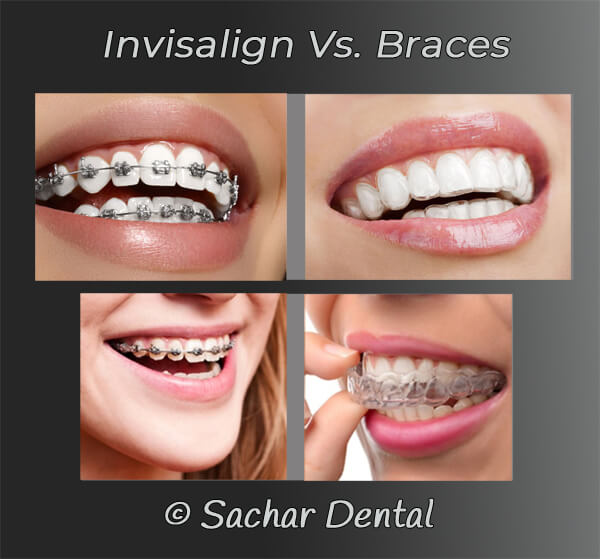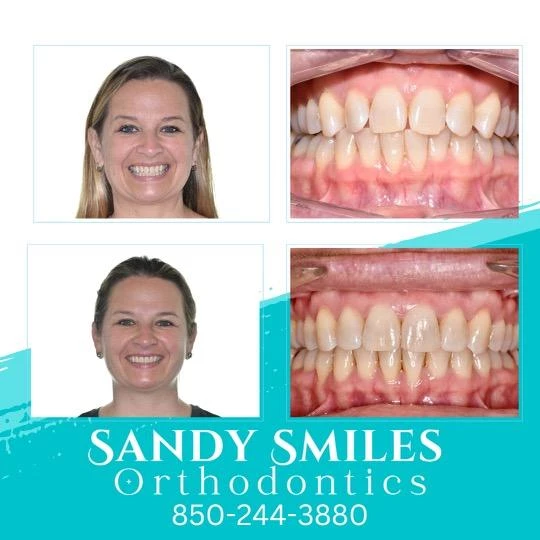Invisalign vs. Conventional Dental braces: Which Option Is Right for You?
When considering orthodontic therapy, the option between Invisalign and typical dental braces presents numerous essential variables that warrant careful assessment. Invisalign offers a very discreet alternative with removable aligners, while conventional dental braces offer an extra noticeable yet effective service for extreme misalignment. Each alternative encompasses unique advantages and disadvantages related to appearances, comfort, therapy duration, and cost. Recognizing these nuances is critical for making an informed decision that straightens with your personal preferences and way of living. The question continues to be: which choice will ideal meet your orthodontic requirements and assumptions?
Introduction of Therapy Options

On the other hand, standard braces are composed of steel braces and wires that are bound to the teeth. This approach applies continuous pressure with time to achieve positioning. While reliable for intricate orthodontic problems, standard dental braces require regular visits for changes and can position difficulties in keeping dental health due to the problem of cleansing about wires and brackets.
Both alternatives have their advantages, and the option usually rests on specific dental conditions, way of living choices, and person conformity. Inevitably, speaking with an orthodontic expert is crucial for figuring out one of the most appropriate treatment plan tailored to private requirements. Recognizing the subtleties of each choice can substantially affect the total success of orthodontic treatment.
Visual Factors To Consider
A considerable aspect influencing the selection in between Invisalign and typical braces is the visual charm each therapy supplies. Invisalign aligners are crafted from clear plastic, making them basically undetectable when worn.
In comparison, conventional dental braces consist of metal brackets and cables, which can be more obvious. While advancements in orthodontic innovation have caused the growth of smaller brackets and colored elastics, typical braces still preserve an even more obvious profile. For some individuals, the presence of braces may prevent them from looking for necessary treatment.
Inevitably, the selection between Invisalign and conventional dental braces might depend upon individual preferences pertaining to appearances. Patients who prioritize discretion usually favor Invisalign, while those who are less concerned about exposure might go with typical dental braces. Understanding the aesthetic implications of each alternative is crucial for making an informed decision that aligns with one's lifestyle and choices.
Convenience and Convenience

In regards to comfort, Invisalign aligners are removable, allowing clients to appreciate their preferred foods without constraint and preserve optimum oral health. Cleaning and flossing are streamlined, as the aligners can be secured throughout these routines, whereas standard dental braces need cautious maneuvering around cords and braces.
In contrast, typical braces demand routine adjustments, making them less practical for those with busy routines. In general, the convenience and benefit of Invisalign make it an attractive choice for several individuals looking for orthodontic treatment.
Therapy Period and Efficiency
While both Invisalign and typical braces are efficient in dealing with dental imbalances, the period of therapy can vary dramatically right here between the 2 options. Normally, Invisalign therapy can take anywhere from 12 to 18 months, depending on the intricacy of the case. The clear aligners work by progressively changing teeth into their preferred settings, and regular follow-ups with an orthodontist assistance make sure progress remains on the right track.
On the other hand, traditional braces commonly call for a longer dedication, usually ranging from 18 months to 3 years. This results from their set nature and making use of wires and braces, which can be a lot more effective for complicated situations and extreme imbalances (Invisalign). The therapy performance of traditional braces is well-documented, as they enable accurate modifications and higher control over tooth motion
Eventually, the option between Invisalign and standard braces may hinge on both the anticipated treatment period and the details oral concerns available. Consulting with an orthodontist is critical, as they can provide tailored referrals based upon private requirements, making sure the selected technique lines up with desired outcomes and durations.
Price Contrast and Insurance Policy Alternatives
Expense plays a considerable role in the decision-making procedure for individuals thinking about orthodontic treatment, whether opting for Invisalign or typical dental braces. Generally, the price of Invisalign varieties from $3,000 to $8,000, while conventional braces typically set you back between $2,000 and $6,000. Elements affecting these expenses consist of the complexity of the case, the period of treatment, and geographical area.
Insurance policy coverage can significantly impact out-of-pocket expenditures. Numerous oral insurance coverage plans give partial protection for orthodontic therapies, however the specifics can differ widely. It is crucial for individuals to review their insurance plan to figure out the level of protection for either alternative. Generally, standard braces may be a lot more frequently covered by insurance coverage strategies compared to Invisalign, which some insurance firms categorize as a cosmetic procedure.
In addition, numerous orthodontic practices supply versatile layaway plan, making both therapy choices much more obtainable. People ought to ask concerning potential financing options and price this content cuts for in advance repayments. Evaluating the complete cost, including insurance policy advantages and layaway plan, is necessary for making an educated choice that aligns with both visual preferences and spending plan factors to consider.

Verdict
In summary, the selection between Invisalign and typical braces rests on several elements, consisting of aesthetic choices, convenience, treatment period, and cost. Invisalign provides a very discreet, detachable choice that facilitates oral hygiene and nutritional flexibility, while standard braces may be better for complex dental problems and usually come at a reduced cost point. Ultimately, consultation with an orthodontist is crucial to examine specific conditions and establish click one of the most suitable therapy alternative for achieving optimum oral positioning.
When taking into consideration orthodontic treatment, the choice in between Invisalign and standard braces presents several crucial variables that merit cautious analysis.Comparing Invisalign and traditional braces discloses unique treatment options for orthodontic modification.While both Invisalign and standard dental braces are reliable in remedying oral misalignments, the duration of treatment can vary considerably between the two choices.Expense plays a considerable duty in the decision-making procedure for individuals considering orthodontic therapy, whether deciding for Invisalign or standard dental braces.In summary, the option between Invisalign and traditional braces hinges on several factors, including aesthetic preferences, comfort, therapy duration, and expense.